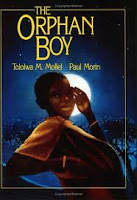This will be our last week of school before the March break! We have a lot to finish up and a couple field trips!
Social Studies and Drama
*Folklore, history and personal narratives are all weaved together in our program.
How can folktales tell you about a civilization?
Civilization = any type of culture, society, etc., of a specific place, time, or group: Greek civilization. Social Studies focus: Early Civilizations (Gr.5) Medieval Times (Gr. 4)


What is your personal narrative, or life story? We shared our own stories about different themes such as most memorable birthday or vacation, or greatest fears. How descriptive were you in the 30 seconds you had to speak?
*Activity: Memory Maps
Success Criteria:
-tell an accurate story from the perspective of a charater (Kiliken, Old Man) in the African folktale The Orphan Boy-select visual images from the character's journey, such as cultural symbols or items, people, objects, or setting
-organize the images, or memories, in a way that's easy to see, understand and follow
-create an overall map of important events and relationships from your character's point of view
March Break
What plans will you be making for an awesome break? If you make a must-do-activities list, bring it to class and we can share ideas. Do you know of a good resource or website that has ideas or information on March Break activities for kids and families? If so, post it in the comment section!
To get you started, here are some websites I found:
http://www.seetorontonow.com/
www.rogerscentre.com/SpringFling
www.toronto.ca/parks/marchbreak.htm
http://toronto.about.com/od/eventsattractions/a/marchbreak.htm
French
*Retest later this week (possibly Friday)
Reading and Writing
Do you think that Family Day is worth its cost to Ontario residents?
*We did some reading in class of articles from a news source and 2 websites. What was the most important thing you learned about Statutory Holidays?
*We are writing persuasive letters to Dalton McGuinty, Ontario's Premier and leader of the Liberal Party, to convince him to keep Family Day or discontinue it.
Success Criteria
-use features of a formal letter (date, greeting, body, salutation, signature)
-identify the issue and your point of view/opinion
-create an argument to support your point of view including 2 strong reasons and 1 opposing reason (show a different point of view) with examples (personal, current events, facts about Family Day)
-organize your argument in paragraphs with topic sentences
-use inclusive language (i.e. hello, thank you, I appreciate) and descriptive language
-produce a neat, organized and revised final draft
Resources for Research
*For more information on Family Day in Canada, visit:
*Questions to research - Inquire for yourself and ask some questions
(How much does Family Day cost the province? Are most families using Family Day to do spend quality time with each other?)
The Honorable Dalton McGuinty
Example of a Persuasive Letter
Read the following letter. Using the Success Criteria, what level would you give it? Why?
Fri.Feb. 23, 2012
Dear Mr. McGuinty,
Hello. My name is Dorit Perlmutter and I am a teacher at Jesse Ketchum Public School in downtown Toronto (just north of your office). I'm writing you today because I do not support Family Day and believe this provincial holiday should be discontinued.
We live in an expanding city with many needs. The cost to afford Family Day comes at a high expense to Ontario. The money could be better used to pay for improving transportation, adding more garbage bins to the streets or even build food banks to help the homeless. Family Day is too expensive.
We already have a two-day weekend, unlike some countries, to set family time. It takes some planning but often on Sunday afternoons, my family goes to the movies or plays Monopoly.
I understand that Family Day can bring some families closer. However, it may just come at too high of a cost. Perhaps we can promote the important of families with a cheaper alternative, like putting posters around the city of families doing different activities together.
Thank you for your consideration of this important issue.
Sincerely,
D. Perlmutter
Math
*We had a quiz on the following topics:
-using a grid to find perimeter and area of polygons
-linear dimensions
-relating units of measure
-solving measurement problems
What new questions might you have about measurement?
*We continue to learn about Measurement.
When might you use non-standard units of measurement?
How might you measure area and perimeter for figures that are not polygons, such as a footprint or your hand?
Science
*The correct response to the blog's science survey was: STILL OBJECTS DO NOT PRODUCE A FORCE. This statemenet is in fact FALSE. Still objects DO produce a force.
*New unit in March and April - Understanding Matter and Energy
Changes in Matter (Gr.5) Light and Sound (Gr.4)

Special Events
*Wednesday - Spirit Day (wear Jesse Ketchum school colours red and black)
- Yorkville Gallery Walk (9:45 a.m. to 11:30 a.m.)
Why is ART important? How does ART change over time? How can ART influence, inspire and/or change people? How can ART represent a civilization?
*Friday - Spirit Day (wear pajamas)
-Going to see The Lorax (focus on environmental themes - see website link below to play the game)
Visit the link to play Save the Trees:








 Storytelling at Jesse Ketchum *Storytelling has begun! Students have chosen short stories and teachers are available at recesses and lunches to provide support. The event will happen after March Break, giving you plenty of time to either get on board if you haven't already or to continue practicing!
Storytelling at Jesse Ketchum *Storytelling has begun! Students have chosen short stories and teachers are available at recesses and lunches to provide support. The event will happen after March Break, giving you plenty of time to either get on board if you haven't already or to continue practicing!






















